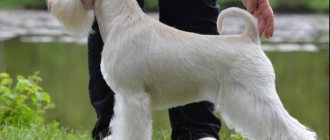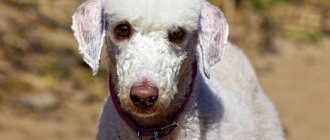Features of the profession
Handling is a section of cynology devoted to the art of demonstrating dogs at exhibitions, as well as preparing for them.
The process of demonstrating the pet to the jury includes trotting along a given figure (circle, straight line, triangle, etc.), showing it in a stand, showing teeth, bite.
In order for your dog to pass these stages flawlessly, you need to prepare it. Firstly, teach her how to behave in the ring. This type of training is called ring training. Secondly, prepare the exterior: cut, comb, etc.
The handler’s task is to show his protégé in such a way as to emphasize his strengths and camouflage his shortcomings. And of course, it is important that the dog next to the handler feels confident and looks like a winner. Because an insecure dog has no chance of winning, no matter how beautiful and purebred it is.
Of course, the dog’s own owner can also prepare and introduce the dog. But he approaches the process as an amateur, and can make annoying mistakes. For example, in order to stop a fight between two excited dogs in the bud or to position the dog so that the chest appears wider and the paws appear stronger, professional skills are needed. Therefore, dog owners are increasingly turning to specialists for help. A dog with good conformation under the guidance of a competent handler can count on a good show career. The handler develops a show schedule for the dog and prepares it taking into account this schedule.
Handler skills
Often, coaches work with several students at the same time. Some prefer to train representatives of only decorative breeds, since they perfectly know their standards and nature’s character, being able to emphasize their advantages, while others are interested in working with different breeds and sizes.
An experienced expert will immediately assess the animal’s exhibition prospects. It should be borne in mind that even the most elite show-class puppy may be left without awards if there were more confident, prepared and better representatives at the exhibition. The main thing to remember is that the dog needs attention and participation not only during training and events, but also after. The handler and owners should encourage the animal, instilling confidence in their goodwill and love, regardless of the results of the competition.
In addition to training, the specialist must have knowledge in related areas, also related to the presentation of dogs. Some independently provide services such as nail trimming, hair trimming, teeth brushing, and styling, while others refer them to highly specialized professionals called groomers.
What you need to know about handlers
Handling dogs is comparable to art. In a short time, the specialist should become friends with your dog and gain its trust. After this, the process of training before the performance begins. It is better to start this preparation 3-4 months before the exhibition so that your dog can adapt to handling. The handler and your pet face a difficult but interesting task. At the exhibition there are strict rules for assessing the exterior, training and quality of the breed, and in order to have a chance to win, the dog must pass the following tests:
Showing experts the bite and presence of teeth; Trotting with a group of other dogs; Trotting along a given route; Fixed exterior stand for 2-3 minutes. The dog handler must not only prepare the dog for performance in the ring, but also guide it through all stages. The main task is to show all the best qualities of the pet and hide its shortcomings from picky judges. Handling professionals are people who subtly respond to their client’s reaction to commands and external stimuli. They are required to know all the standards of a particular breed and the requirements of experts when assessing them. All features of the behavior and appearance of a particular dog must be presented in the best light, and there are no trifles here.
To emphasize the features of the exterior, the tone and style of clothing and shoes are selected. For example, to show a black terrier, light-colored trousers and a jacket are most likely suitable so that the dog is clearly visible against the background of the handler. But the character of the dog must be taken into account when choosing the speed of movement when passing a route or moving in a group. In addition, it is necessary to constantly move so that when performing all tasks the dog is in front of the expert, thus allowing him to examine all the features of behavior and appearance. Even the type of leash and collar the dog is wearing plays a big role. A leash that is too tight spoils the cleanliness of the neck line, and sharp tugging movements throw the dog out of rhythm and can frighten him. The art of handling lies in presenting the dog in the ring, while remaining practically unnoticeable, controlling the behavior of the examinee with calm, subtle movements.
Such different handling
Historically, there have been three main areas of handling. They are connected with the peculiarities of holding ring competitions in England, Germany and the USA. Depending on the rules of the competition and the country where it is held, the handler chooses a training system.
The English style is considered the most strict and difficult to master. It implies that the dog independently gets into an exterior stance without human intervention. Due to the strict requirements of the experts when judging dogs according to these rules and the complexity of preparation for the ring, this style of handling is common mainly in the UK. However, competitions among the Labrador breed are traditionally held in the English style on all continents.
The German style is distinguished by the participation of two handlers at the show of each dog
One of them directly leads the ward in the ring, and the second is outside it and attracts the dog’s attention to himself. According to one version, this approach to ring performances appeared due to the aggressiveness of German guard breeds and the need to constantly concentrate their attention on a familiar person
Currently, the spread of this style of display in the world is gradually decreasing.
The most common direction now is the American direction. To perform the exterior stance at competitions of this style, the handler himself places the dog in the required position. The passage through the figures is carried out by one handler without outside help. Another feature of the American style is the strictly defined format of clothing for handlers. Mandatory attributes of a men's suit are trousers and a shirt, and a women's suit is a skirt and blouse. Women's pantsuits are not permitted. All shoes must have low, soft soles without heels.
Handling in the CIS countries became widespread relatively recently, but the rich cynological traditions of the USSR period allowed the rapid emergence of high-class domestic professionals, who are now appreciated all over the world.
Don't forget to subscribe to the channel so you don't miss new posts! And psst... I'm pleased when you read in full and like it.
Dress code in clothing
Presentation is extremely important at trade shows. This applies to both competitors and trainers representing dogs. The judges evaluate the combination in pairs and each participant separately. Therefore, clothing and behavior should be correlated with the appearance of the ward.
Dress code in clothing:
- Convenience, neatness. Freedom in clothing that does not restrict movement and does not interfere with movement is encouraged. Cleanliness and neatness are requirements that are not discussed. This is an indicator of professionalism.
- Shade of clothing. The handler should choose a costume in such a way as to favorably emphasize the color of the pet’s coat. The main thing is contrasting colors. Otherwise, the clothes will merge with the wool, which will prevent you from assessing the advantages of the contestant. If the dog has a light coat, then the trousers should be black and vice versa.
- Shoes. The main requirements are comfort and convenience. Women need to give up heels. It is better to choose sneakers, as they will provide the lightness needed during constant jogging. The advantage of shoes without heels is to prevent injury if the trainer accidentally steps on a paw.
Don't wear clothes that are too loose. Women are advised to avoid short skirts, low-cut blouses, bright makeup, jewelry and high hairstyles. The handler's appearance should not take the judges' attention away from the main participant - the dog.
Responsibilities of a specialist
Handlers, dog handlers and other professionals who work with dogs have quite a few responsibilities. This is due to the need not only to train the animal, but also to carefully care for it.
List of main responsibilities:
- selection of a training complex;
- daily dog activities;
- studying modern approaches to training;
- adjusting the dog's diet;
- coat care;
- familiarization with the results of exhibitions;
- Regular monitoring of your pet's health.
Dog handling styles
If previously the concept of “handling” existed only in America, today it is becoming increasingly popular in European countries. This word translated from English literally means “the ability to handle someone or something.”
From the point of view of cynology, handling is the display of dogs at exhibitions and competitions, and the handler is the one who, in fact, brings out and demonstrates all the advantages of the competitor. It is noteworthy that in America the tradition of handling did not begin with dogs at all - it was in horse breeding that this concept originated: the first handlers held exhibitions and shows of noble horses.
Did you know? The first dog show took place in England in 1860, where only pointer and setter breeds participated.
Exhibitions and displays of dog breeds have become widespread since the beginning of the twentieth century. In the 70s, television broadcasts of various dog shows began. Today, the handler profession is very popular in certain professional circles - both domestic and foreign. The purpose of holding shows is not only the opportunity to win medals - it is also the socialization of the dog, meeting potential brides and grooms, and getting to know other breeds.
Handling styles were formed gradually, and to a greater extent they depended on the individuality of the handler, the breed of dog, the location of the show, etc. In fact, a handler can be compared to an artist - just like an artist can choose any style to paint and sell his painting, Likewise, the handler can use his own personal style to present the animal.
Nevertheless, among the total mass of styles of handling, 3 main ones stood out and formed:
American. It is the most popular and accessible. This style allows you to most advantageously emphasize all the advantages of the breed and hide the shortcomings (if any). The essence: each paw is placed separately, slowly rising and falling - the animal is like a construction set, assembled in parts. It looks very impressive - but to achieve the correct behavior of the animal and its precise execution of commands, it will take a lot of time and effort.
English. It is called free style - the breed is shown without the hands of the handler, the dog itself must ideally stand in the required position. In order for the animal to correctly and accurately perform the exercise, full contact between the pet and the owner, mutual understanding, trust and a lot of time for training is needed. In addition, the dog must be interested in order to willingly perform the desired stance. Today, in all exhibitions and shows, the only breed that can demonstrate the English style is the Labrador.
German. They are called double - due to the fact that 2 people participate in the display of the animal. Used mainly for German breeds such as Shepherds, Great Danes, Rottweilers, Dobermans, etc.
While the main handler keeps the dog on a tight leash, the second assistant from behind the stage attracts the dog’s attention in various ways: offers food, throws a toy, etc.
This style is the most welcomed in shows - noise, a lot of fuss and distraction provoke dissatisfaction among dog handlers. Europeans rarely use this style, and Americans have abandoned it altogether.











